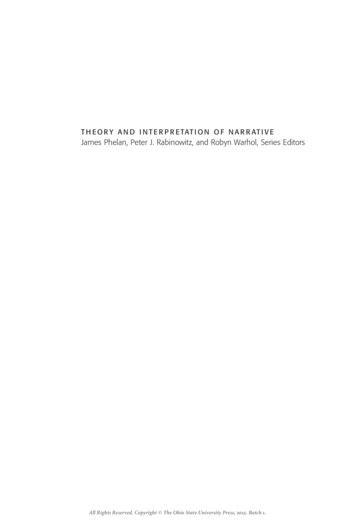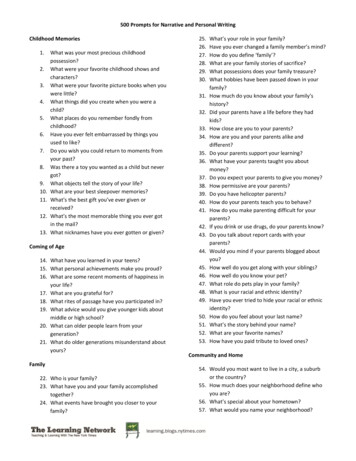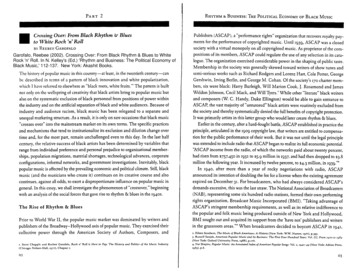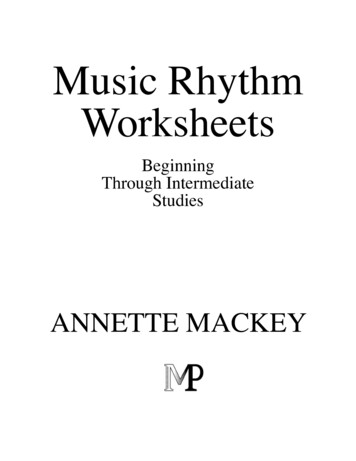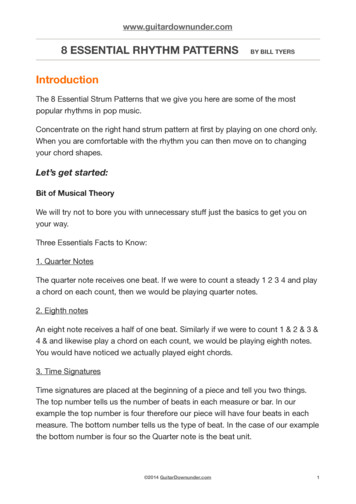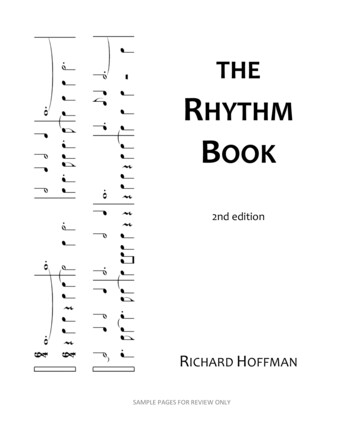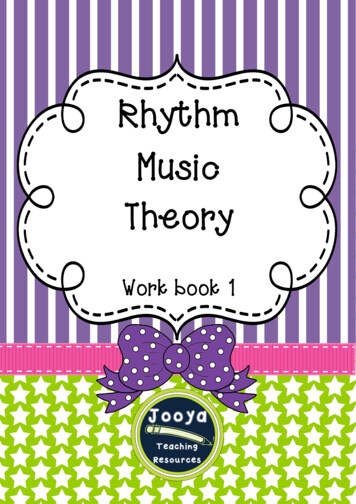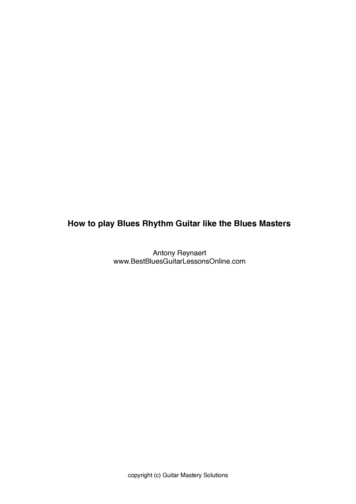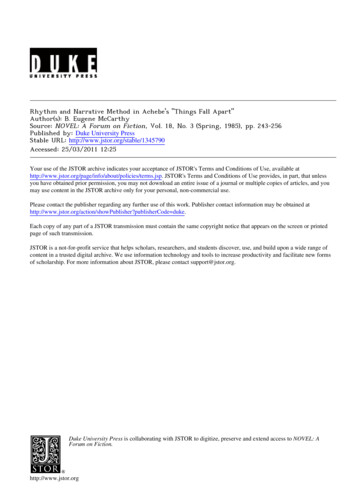
Transcription
Rhythm and Narrative Method in Achebe's "Things Fall Apart"Author(s): B. Eugene McCarthySource: NOVEL: A Forum on Fiction, Vol. 18, No. 3 (Spring, 1985), pp. 243-256Published by: Duke University PressStable URL: http://www.jstor.org/stable/1345790 .Accessed: 25/03/2011 12:25Your use of the JSTOR archive indicates your acceptance of JSTOR's Terms and Conditions of Use, available at ms.jsp. JSTOR's Terms and Conditions of Use provides, in part, that unlessyou have obtained prior permission, you may not download an entire issue of a journal or multiple copies of articles, and youmay use content in the JSTOR archive only for your personal, non-commercial use.Please contact the publisher regarding any further use of this work. Publisher contact information may be obtained at erCode duke. .Each copy of any part of a JSTOR transmission must contain the same copyright notice that appears on the screen or printedpage of such transmission.JSTOR is a not-for-profit service that helps scholars, researchers, and students discover, use, and build upon a wide range ofcontent in a trusted digital archive. We use information technology and tools to increase productivity and facilitate new formsof scholarship. For more information about JSTOR, please contact support@jstor.org.Duke University Press is collaborating with JSTOR to digitize, preserve and extend access to NOVEL: AForum on Fiction.http://www.jstor.org
RhythmandNarrativeMethodin Achebe'sThings Fall ApartB. EUGENE McCARTHYBefore the publication of Chinua Achebe's Things Fall Apart in 1958 publicawareness in the West of fiction from Africa was confined chiefly to whitewriters such as Doris Lessing, Alan Paton, or Nadine Gordimer. Thus Achebe'sfirst novel, written in English, though he is himself a Nigerian of the Igbopeople, was a notable event. More noteworthy was the fact that it was a verygood novel and has become over the years probably the most widely read andtalked about African novel, overshadowing the efforts of other West Africannovelists as well as those of East and South Africa. Its reputation began highand has remained so, stimulating critical analysis in hundreds of articles, manybooks, and dissertations. Its story describes, whatever one may expect from itsYeatsian title, the life of a traditional Igbo rural village and the rise of one ofits gifted leaders, Okonkwo, before colonization, and then observes the consequences for the village and the hero as they confront the beginnings of thecolonial process. Achebe's subsequent three novels, more or less related but notsequential, No Longer At Ease (1960), Arrow of God (1964), and Man of thePeople (1966), though all respected, have not matched its success. Achebe'sfiction established firmly that there is an African prose literature-poetry hadprobably been well known since Senghor in the 1940s-even when written inEnglish. Not that there has not been debate over and criticism of Things FallApart, and from Achebe's standpoint a good deal of misunderstanding throughrefusal of readers to take its African character seriously; but as a recent studyconfirms he continues to be "the most widely read of contemporary Africanwriters." 1 His first novel has been "as big a factor in the formation of a youngWest African's picture of his past, and of his relation to it, as any of the stillrather distorted teachings of the pulpit and the primary school," 2 and of coursehe has influenced his fellow writers just as significantly in finding their ownsubject matter and voice.When beginning Chinua Achebe's novel Things Fall Apart, readers are oftenstruck by the simple mode of narration and equally simple prose style, whichcritics have seen as Achebe's desire to achieve an "English . . . colored to reflectthe African verbal style [with] stresses and emphases that would be eccentricand unexpected in British or American speech." 3 He reshapes English in orderL. Innes and Bernth Lindfors, eds., Critical Perspectives on Chinua Achebe (Washington, D.C.: ThreeContinents Press, 1978), p. 1.1C.2 Ibid., p. 5, quoting from TLS in 1965.8 John Povey, "The English Language of the Contemporary African Novel," Critique XI, 3 (1969), 93.
NOVEL SPRING 1985244to imitate the "linguistic patterns of his mother tongue," Igbo.4 I would like,as a further means of understanding this special quality of Achebe's prose, topropose a way of reading and of understanding the novel through the conceptof rhythm, within the oral tradition.In the opening passage of the novel, the narrator's repetition of words andphrases, both verbatim and synonymous, and his mode of emphasis and patterning suggest a deliberateness and complexity well beyond the surface simplicity:aAOkonkwo was well known throughout the nine villages and even beyond.aAHis fame rested on solid personal achievements. As a young man of eighteenBaAcche had brought honour to his village by throwing Amalinze the Cat. AmalinzeDwas the great wrestler who for seven years was unbeaten, from Umuofia tocMbaino. He was called the Cat because his back would never touch the earth.BAcIt was this man that Okonkwo threw in a fight which the old men agreed wasEEone of the fiercest since the founder of their town engaged a spirit of the wildDfor seven days and seven nights.The drums beat and the flutes sang and the spectators held their breath.cEEAAmalinze was a wily craftsman, but Okonkwo was as slippery as a fish inEwater. Every nerve and every muscle stood out on their arms, on their backsEand their thighs, and one almost heard them stretching to breaking point. InABCthe end Okonkwo threw the Cat.5The narrator's repetitions in this passage are a technique of the traditionaloral storyteller, sitting talking to a group of listeners (though he is not a griot,or oral historian).6 For example, the subject "A" repeats four times, the modifier"a" repeats but varies to add meanings; other words, such as those about theintensity of the fight, likewise are repeated to emphasize their importance and tovary meanings. Walter Ong refines our understanding of oral thought andexpression in prose by pointing out that the oral narrator's "thought must comeinto being in heavily rhythmic, balanced patterns, in repetitions and antitheses,in alliterations and assonances, in epithetic and other formulary expressions."4 Ihechukwu Madubuike, "Achebe's Ideas on African Literature," New Letters 40, 4 (1974), 87.5 Chinua Achebe, Things Fall Apart (London: Heinemann, 1958), p. 3. All subsequent quotations from the textare from this edition. Note: the word "men" above is written "man" in the text, which seems inconsistentwith the referent "founder of their town."6 Meki Nzewi, "Ancestral Polyphony," African Arts 11, 4 (1978), 94: "But Chinua does not see a linkbetween the modern Igbo novelist and the traditional storyteller." According to Professor Chidi Ikonneof Harvard University the narrator is not a griot (from private conversation). Yet Kofi Awoonor, TheBreast of the Earth (Garden City, N.Y.: Doubleday, 1976), p. 257, adds, there is a "straight-forwardsimplicity about the language . . . that recalls the raconteur's voice."
B. EUGENE MC CARTHYIACHEBE'SRHYTHMS245Such primarydevices for memory ("for rhythm aids recall")and communicationsimplify the story so that the listeners can grasp charactersand events graphically and surely. More specifically, oral expression is "additive rather thansubordinative,""aggregativerather than analytical,""redundantor 'copious,'"that is, "backlooping"by means of "redundancy,repetition of the just-said."7The additive and redundantelements are apparentin the above passage, whenAchebe's narrator repeats a phrase, for example, "Amalinze the Cat," thencarries it forward with new information.Once a name or event is introducedhe proceeds by moving forward, then reaching back to repeat and expand,moving onward again, accumulating detail and elaborating: "well known"advances to "fame" and to "honour,"just as "It was this man that Okonkwothrew" repeats what has gone before and underlines its importance. Karl H.Bottchercalls the narrator'smethod "afterthoughts,"8 but Ong's "backlooping"conveys better the active methodologyof the narrator.The style is not "aggregative"for key epithets are not attachedto characters,no doubt because the novel is written, not spoken. A more importantdeparturefrom strict oral procedureis the narrator'sdistance from his charactersand hisreluctanceto intrude his views, for as Ong tells us, empathy and participationare elements of orality, objectivity a consequenceof writing.9For the most partthe narratorreveals only what was done or said by others: "a fight which theold men agreed was one of the fiercest. . ," "it was said that, when he slept. . .,""he seemed to walk on springs, as if. ." We understand an apparent intrusionsuch as the following as reflectingnot the narrator'sbias but the way the peoplethought: "When Unoka died he had taken no title at all and he was heavilyin debt. Any wonder then that his son Okonkwo was ashamed of him? Fortunately, among these people a man was judged accordingto his worth and notaccordingto the worth of his father"(6).The patterning and repetition in Achebe's novel are characteristicsof theself-conscious artistry of oral narrative performance, where plot moves byrepetition and predictability.Harold Scheub argues the "centralityof repetitionin oral narrativesas a means of establishingrhythm."10Such rhythmictexturesestablish the narrativemethod as imitative of the African oral rather than theEnglish "literary"tradition. Indeed rhythm is a quality at the heart of Africanculture.LeopoldSedarSenghorhas written:"Rhythmis the architectureof being,the inner dynamic that gives it form, the pure expressionof the life force." TheWalter J. Ong, S.J., Orality and Literacy (London: Methuen, 1982), pp. 34, 37-40. Ong says Achebe's NoLonger at Ease "draws directly on Ibo oral tradition . . . [providing] instances of thought patterns inorally educated characters who move in these oral, mnemonically tooled grooves," p. 35.8 Karl H. Bottcher, "The Narrative Technique in Achebe's Novels," New African Literature and the Arts713/14 (1972), 7.9 Ong, pp. 45-46. See Bottcher on narrator's distance, pp. 1-5.10 Unpublished essay as quoted by Ron Scollon, "Rhythmic Integration of Ordinary Talk," in AnalyzingDiscourse: Text and Talk, ed. Deborah Tannen (Georgetown: Georgetown University Press, 1982), p. 337.See also Emmanuel Obeichina, Culture, Tradition and Society in the West African Novel (Cambridge:Cambridge University Press, 1975), p. 174: "The main impulse in [Nigerian novelist Gabriel Okara's]The Voice obviously derives from the oral tradition . . . especially his deliberate repetitions, his metaphorical and hyperbolic elaborations and his colloquial rhythm."
NOVEL SPRING 1985246dramatic interest of a work is not sustained, he writes, by "avoiding repetitionas in European narrative. . . , [but] is born of repetition: repetition of a fact, ofa gesture, of words that form a leitmotiv. There is always the introduction of anew element, variation of the repetition, unity in diversity." '1 In the text wherehe quotes this statement, Jahnheinz Jahn illustrates prose rhythms with a passagefrom Nigerian writer Amos Tutuola's Palm-Wine Drinkard: "the rhythmicalkind of narrative in which the repetition intensifies the dramatic quality of theaction, makes Tutuola's story oral literature." 12As Robert Kellogg tells us, there are many sorts of rhythm, "phonic, metrical,grammatical, metaphoric, imagistic, thematic";13 and modern studies have arguedthat prose as well as verse has its rhythms, usually found first in syntax.14 Therepetitions of syntactic patterns of word and phrase underscore emphases (sometimes vocal) and stresses of meaning. Thus Roger Fowler describes in passagesfrom David Storey the syntactic repetitions by which "syntax becomes rhythmical" and finds "sentence- and phrase-rhythms" there like "'thickening, deepening, then darkening' ": "When syntax is repetitious, highlighting by reiterationa small number of patterns," he argues, "a palpable rhythm is established throughthe regularity of voice tunes." 15 Such repetition is the most obvious stylisticfeature we notice in the passage from Achebe's novel. Syntactically, these repetitions stress key words, oftefn polysyllables in contrast to the predominating oneor two syllable words, chiefly subject nouns, object nouns, pronouns andmodifiers of these nouns, and verbs, with occasional stress on time or place.Though emphasis may be difficult to assess uniformly-e.g.,"through theNINE villages," or "through the NINE VILLAGES," or even possibly "throughthe nine VILLAGES"-there are some evident emphases on subjects, objects, orverbs; for example, "In the end Okonkwo threw the Cat" stresses all three.Parallelism enhances the repetitions and strengthens the rhythms: the parallel11 Quoted in Jahnheinz Jahn, Muntu (New York: Grove Press, 1961), pp. 164-66. See original, Senghor,"L'Esthetique Negro-Africaine," Liberte I, Negritude et Humanisme (Paris: Editions du Seuil, 1964),pp. 211-12; and his premise: "Image et rythme, ce sont les deux traits fondamentaux du stylenegro-africain," p. 209. See also Obeichina: "The most striking feature of Okara's art is the repetition ofsingle words, phrases, sentences, images or symbols, a feature highly developed in traditional narrative," p. 173; and Daniel P. Biebuyck, Hero and Chief, Epic Literature from the Banyanga (Zaire Republic)(Berkeley: University of California Press, 1978), p. 79: "Somewhat related to the formulaic system arethe innumerable repetitions that add emphasis, effect, clarity and thus give fullness to the description[and] lend sonority, additional rhythm, and emphasis to the statements."12 Ibid., p. 168.13 Robert Kellogg, "Literature, Nonliterature, and Oral Tradition," New Literary History 8 (Spring, 1977),532. This issue of NLH has a valuable collection of essays on "Oral Cultures and Oral Performances."14 Roger Fowler, Linguistics and the Novel(London: Methuen, 1977), p. 28: "the surface structure of a text(which is a sequence of sentences) has, like the surface structure of a sentence, qualities such as sequence,rhythm, spatial and temporal expressiveness." Raymond Chapman, The Language of English Literature(London: Edward Arnold, 1982), pp. 84-85: "We have seen that the traditional metres of English poetryhavesomeconnectionwiththe rhythmsof ordinaryspeech. . . Rhythmof courseis not confinedtopoetry . . . prose can have its distinctive cadences." Richard Ohmann, "Generative Grammars and theConcept of Literary Style," in Linguistics and Literary Style, ed. Donald Freeman (New York: Holt, Rinehart and Winston, 1970; previously published 1964), p. 260: "let me state this dogmatically-in prose, atleast, rhythm as perceived is largely dependent upon syntax, and even upon content, not upon stress,intonation, and juncture alone."15 Fowler, pp. 60, 63. See also Michael Riffaterre, "Criteria for Style Analysis," in Essays on the Languageof Literature, eds. Seymour Chapman and Samuel Levin (Boston: Houghton Mifflin, 1967), pp. 428-29.
B.EUGENEMC CARTHYIACHEBE'SRHYTHMS247subject-verb sentence opening: "Okonkwo was" with "fame rested," or"Amalinze was" with "he was" with "It was." In the third (unquoted) paragraph, the parallel repetitions become insistent, as the verbs become increasinglyactive: "he was tall," "he breathed," "he slept," "he walked," "he seemed towalk," "He was going," "he did pounce," "he had," and finally, "He had nopatience. . . ." Alliteration too accents these repetitions: "called" and "Cat";"fight," "fiercest," and "founder"; "Spirit," "seven," and "seven." One may evendiscern a distinct metrical rhythm in some lines, such as, "The drums beat and theflutes sang and the spectators held their breath," which could be marked, short,long, long; short, short, long, long, and so on. The third paragraph summarizeswith a strongly trochaic, blues-like line: "That was many years ago, twenty yearsor more," but the near domination of metric regularity changes to "and during thistime, Okonkwo's fame . . ." If there is such a thing as a dominant meter in prose(English is considered to be naturally iambic),16 Achebe's prose would seem to belargely anapestic: "It was this/ man that Okon/kwo threw/ in a fight/ whichthe old/ men agreed/ was one/ of the fierc/est since the found/er of their town/engaged a spir/it of the wild/ for sev/en days/ and sev/en nights," ending witha series of four iambs. Note another anapestic line: "Every nerve/ and everymus/cle stood out/ on their arms/ on their backs/ and their thighs." The pointhere is not to scan the lines but to show the rhythmical quality of the prose,more markedly rhythmical than traditional English prose, closer to an oralAfrican quality.I will explore now further levels of rhythm in the novel, moving from thestylistic to the structural, and then to the thematic, for not only the style but theentire narrative method can be considered rhythmical. Critics have mentionedthe structuring of events in the novel in terms of rhythm. According to DavidCarroll, "the narrator then moves from this larger rhythm of the generations tothe rhythm of the seasons, to Okonkwo and his sons repairing the walls; . yetthe compassionate narrative voice seems to establish another rhythm, contrapuntal to Okonkwo's success." 17 S. O. Iyasere says, "Against the joyfullyharmonic rhythm of this event [the locusts], the withdrawn, controlled formalismof the judgment of the egwugu stands in sharp relief. By juxtaposing theseevents, Achebe orchestrates the modulating rhythms of Umoufia." 18 The structural tightness of the novel has been demonstrated by critics such as RobertWren on the novel as a whole,19 and Karl Bottcher on the narrator's voice andother stylistic techniques.20 The narrative procedure that we see in the openingpassages, involving a regular introduction of new materials, a little at a time,16 Raymond Chapman, p. 43: "One of the most common metrical lines in English poetry is the iambicpentameter. . It follows very closely the pattern of everyday speech. . . . The iambic pentameter canbe given many variations, but it remains close to what sounds 'natural' in English."17 DavidCarroll, Chinua Achebe (New York: Twayne, 1970), pp. 37, 47.18 Solomon 0. Iyasere. "Narrative Techniques in 'Things Fall Apart,' " New Letters 40, 3 (1974), 76. Seealso Iyasere, "Oral Tradition in the Criticism of African Literature," Journal of Modern African Studies13, 1 (1975), 111-14.19 Robert Wren, Achebe's World (Washington, D.C.: Three Continents Press,1980), pp. 23 ff.20Bottcher, pp. 1-12.
NOVEL248SPRING1985awaiting further amplification, is similar to African polymetric rhythms inwhich various meters are heard simultaneously, though not introduced at onetime.21 This is not a rhythm of percussive stress or beat, but an accentuationby word, phrase or theme. As our awareness is sharpened to the introduction ofnew materials-the "additive" element of orality-we become aware of themultiple rhythms at work: words that emulate the "redundant" aspect of oralityby early or late repetition (e.g. "breathe," "seven"), themes that are brieflyexpanded or developed later (e.g. fierceness, wrestling), and those such asmasculine and feminine that evolve slowly but consistently. We thus becomemore conscious of the process of development of words, phrases, and themes,and are less likely to overemphasize one and miss another. We will also see thatthe narrative makes increasingly evident a connection between these rhythmicelements of style and form and the basic rhythm of clan life, with the result thatrhythm becomes significant thematically to Okonkwo's response to clan lifeand to the ultimate breaking of that life. I will sketch the pattern of the thirteenchapters of Part One to show how the narrative is laid before us, like pieces ofa complex puzzle that slowly reveal coherence.In Chapter One we meet Okonkwo as a man of great achievement andgreater potential, and we see the heritage of his father the failure, a heritageOkonkwo wishes to flee. But as Okonkwo hastens to achieve his goals he inadvertently becomes involved with the hostage, the boy Ikemefuna whom thenarrator refers to as "doomed" and "ill-fated," though we are unsure why at thispoint. The pacing of Chapter Two is particularly suggestive of the narrativemethod used thereafter in the novel. Set in three parts the chapter begins withOkonkwo, about to go to bed, hearing "a clear overtone of tragedy in the crier'svoice." We drift briefly from that motif to hear lore of the night before wecontinue the episode of Ikemefuna's arrival in Umuofia into the care of Okonkwo. The second part turns abruptly to the character of Okonkwo, "dominatedby fear, the fear of failure and of weakness," specifically of being thought an"agbala," a woman, or a man with no titles, like his father. "And so Okonkwowas ruled by one passion-to hate everything that his father Unoka had loved.One of those things was gentleness and another was idleness" (10). When in thethird part the chapter returns to details of Ikemefuna's arrival-as Bottcher says,"the point of departure is resumed almost word by word" 22-we have in anutshell the whole novel: Okonkwo's passions, hatred of weakness or womanliness, his success and strengths, his connection with the hostage, and theovertones of tragedy.The three parts of Chapter Two offer an episodic advancement of the plot,21 Cf. Jahn, p. 165; and J. H. Kwabena Nketia, The Music of Africa (New York: Norton, 1974), p. 136:"the crucial point in polyrhythmic procedures . . . is the spacing or the placement of rhythmic patternsthat are related to one another at different points in time so as to produce the anticipated integratedstructure." All of Chapter 12 is relevant here. Isadore Okpewho, The Epic in Africa: Toward a Poetic ofOral Performance (New York: Columbia University Press, 1979), pp. 61-2, asks, "What is the nature of thismusical element in African heroic song?" and responds, "one fundamental aspect, its polyrhythmicnature, is relevant here. . . . Polyrhythms . . . vary as one moves from east to west, with West Africaas the region of greatest complexity."22Bottcher,p. 7.
B. EUGENE MC CARTHYIACHEBE'SRHYTHMS249both adding to what has been mentioned and reflecting on the parts to whichthey are juxtaposed for commentary and contrast, as well as introducing newmaterials, all in the oral-rhythmic process of addition of new and amplificationof old themes. Chapter Three, also of three parts (though the chapters varygenerally from one to four parts), begins with Agbala, not the scornful title of"woman" but the Oracle whose priestess people visit "to discover what thefuture held . or to consult the spirits of their departed fathers" (12). Agbala hadonce told Unoka why he was a failure. Now, to overcome the disadvantages of auseless father, Okonkwo visits not Agbala but, more practically, a wealthy manfor a loan of yams to start his own farm. Part Three then reverses the trend ofthe story thus far, for Okonkwo fails, and establishes the possibility of thingsgoing badly to the point of suicide. "The year had gone mad," and all his seedyams have been destroyed. One man hangs himself, but Okonkwo survivesbecause of "his inflexible will."Having established Okonkwo's direction, the narrator wishes to expand thecontext of the novel and offer several correctives, for the implications of theincident of Okonkwo's "survival" are not resolved until Chapter Four. "'Lookingat a king's mouth,' said an old man, 'one would think he never sucked at hismother's breast.' He was talking about Okonkwo" (19), who had indeedforgotten his maternal life, and preferred "to kill a man's spirit" by calling him"woman." Okonkwo's fear of weakness is here qualified as specifically antifeminine: "To show affection was a sign of weakness," so he beats his hostage,and in the next part beats one of his wives in violation of the Week of Peacededicated to the Goddess Ani, an evil act that "'can ruin the whole clan. Theearth goddess whom you have insulted may refuse to give us her increase, andwe shall all perish' " (22).The importance of the feminine element in the culture could be overlookedbecause of the emphasis Okonkwo places on masculine virtues and achievementsfor which he is justly celebrated. But the novel steadfastly points to the centralityof the feminine.23 Okonkwo's masculine sensibility terrorizes his son Nwoyewhom he wishes to be "a great farmer and a great man" (23), and enhances hisaffection for the already manly Ikemefuna, who significantly entertains such"womanly" traits as telling (24) and hearing (42) folk tales. Okonkwo's emphasis on "his inflexible will" as the cause of his survival is corrected here when thenarrator explicitly states, "the personal dynamism required to counter theforces of these extremes of weather would be far too great for the humanframe" (24).One new element is introduced in this chapter, the concern with customs.Since Okonkwo had violated the custom of the Week of Peace, the discussion isappropriate, but its importance here is in revealing that the clan's customs are23For discussions of the feminine, see Ernest Champion, "The Story of a Man and his People," NALF 6(1972), 274; G. D. Killam, The Novels of Chinua Achebe (New York: Africana, 1969), pp. 20 ff.; lyasere,"Narrative. . . ," pp. 79 ff.; Wilfred Cartey, Whispers from a Continent (New York: Random House,1969), Chapter 1, "Mother and Child." Awareness of the masculine/feminine element is now widelymanifested by critics.
250NOVELISPRING1985not absolute: "the punishment for breaking the Peace of Ani had become verymild in their clan." The men mock those clans who do not alter customs as theysee fit: "they lack understanding." If we think too much on change as thingsfalling-apart, we are apt to miss the ameliorative process of change which isinherent in the clan. Throughout the story several old men and some youngmen ponder the sanity of customs, such as the particularly agonizing one ofkilling twins, and we are conscious that eventually it too would be changed.Desire for change, founded in emotional distress, is what brings Nwoye toChristianity for solace.Chapter Five returns to another feast of the Earth Goddess to elaborate herposition. The "source of all fertility[,] Ani played a greater part in the life of thepeople than any other deity. She was the ultimate judge of morality and conduct" (26). During her feast, for which the local women inscribe themselves andtheir huts with detailed patterns, and to which visitors come from the motherland (and reportedly spoil the children!), the violence of Okonkwo once moreerupts. He rages that a tree has been killed-"As a matter of fact the tree wasvery much alive"-and then shoots at his wife, the one who (as we later learn)had left her husband out of admiration for Okonkwo's excellence as a wrestler.The implications of this wild act of shooting eventually become clear for thoughthere was no formal violation of the harvest festival, Okonkwo here mishandlesa gun as he will later do in fatefully killing a boy.The remainder of Chapter Five is filled with the wonderful power of thedrums, like the rhythmic pulse of the heart of the clan, sounding insistentlybehind the action-"Just then the distant beating of drums began to reach them"(30), "The drums were still beating, persistent and unchanging" (31), "In thedistance the drums continued to beat" (32). They are a pulse countered only byOkonkwo's roaring at his daughter Ezinma whom he wished were a boy. Atthis point rhythm takes on thematic dimensions as the narrator contrastsOkonkwo's eccentric or asymmetrical behavior with the rhythmic spirit of theclan. The significance of the drum beat is amplified in the following chapter(Six) where the chief entertainment of the clan, wrestling, takes place on the ilo,the village circle, a dramatic space where the central physical and cultural actsof the people occur (recall the spiritual "dark, endless space in the presence ofAgbala," 12). Later (Chapter Ten) judgments are passed there on major legalcases, and finally (Chapter Twenty-three) when the clan is disrupted and theimagery is of coldness and ashes, no acts take place: "the village ilo where theyhad always gathered for a moon-play was empty" (139). Our attention is drawninexorably to the ilo by the drums so that by the time the celebration begins, wewatch the people drawn in every sense together by the drums, for the drummersare literally "possessed by the spirit of the drums" (33) and their "frantic rhythmwas . . . the very heart-beat of the people" (35-36). Rhythm is central. We areto see this celebration as the focal dramatic act of the dramatic space which is thecenter of the people-harmonic life-as if we as visitors to the clan must see atleast once what rhythm means in its fullest articulation, must be reminded what
B.EUGENEMC CARTHYIACHEBE'SRHYTHMS251it was like when, as the novel opened, Okonkwo threw the Cat, and when now,in almost exact repetition for Okonkwo, for his wife, for the clan, "The muscleson their arms and their thighs and on their backs stood out and twitched, . . .Has he thrown a hundred Cats?He has thrown four hundred Cats." (36)This is the cultural center of the novel-the ilo becomes a metaphor for thedramatic space of the novel, the cultural locus upon which Okonkwo performs,first as wrestler, then as tragic actor. In Achebe's World Robert Wren alsoemphasizes this chapter: the novel's twenty-five chapters "are upon closeranalysis divided into four groups of six chapters each, with one pivotal chapter,XIII, where Okonkwo accidentally kills Ezeudo's son and must flee." 24 Wrengoes on to note that Part One actually "has two six-ch
5 Chinua Achebe, Things Fall Apart (London: Heinemann, 1958), p. 3. All subsequent quotations from the text are from this edition. Note: the word "men" above is written "man" in the text, which seems inconsistent with the referent "founder of their town." 6 Meki Nzewi, "Ancestral Polyphony," African Arts 11


